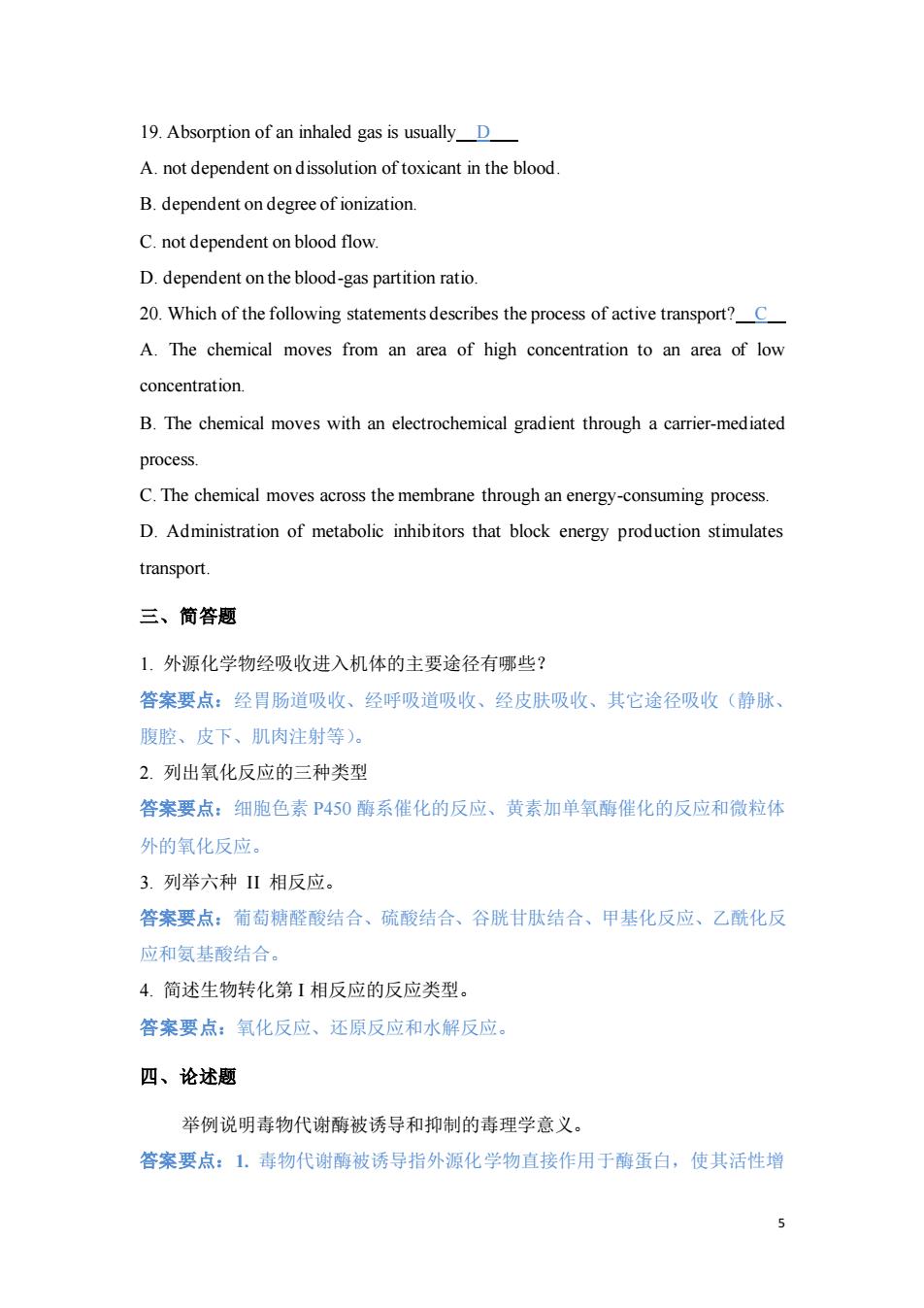正在加载图片...

19.Absorption of an inhaled gas is usually D A.not dependent on dissolution of toxicant in the blood. B.dependent on degree of ionization. C.not dependent on blood flow. D.dependent on the blood-gas partition ratio. 20.Which of the following statements describes the process of active transport?C A.The chemical moves from an area of high concentration to an area of low concentration. B.The chemical moves with an electrochemical gradient through a carrier-mediated process C.The chemical moves across the membrane through an energy-consuming process. D.Administration of metabolic inhibitors that block energy production stimulates transport. 三、简答题 1.外源化学物经吸收进入机体的主要途径有哪些? 答案要点:经胃肠道吸收、经呼吸道吸收、经皮肤吸收、其它途径吸收(静脉、 腹腔、皮下、肌肉注射等)。 2.列出氧化反应的三种类型 答案要点:细胞色素P450酶系催化的反应、黄素加单氧酶催化的反应和微粒体 外的氧化反应。 3.列举六种Ⅱ相反应。 答案要点:葡萄糖醛酸结合、硫酸结合、谷胱甘肽结合、甲基化反应、乙酰化反 应和氨基酸结合。 4.简述生物转化第I相反应的反应类型。 答案要点:氧化反应、还原反应和水解反应。 四、论述题 举例说明毒物代谢酶被诱导和抑制的毒理学意义。 答案要点:1.毒物代谢酶被诱导指外源化学物直接作用于酶蛋白,使其活性增 55 19. Absorption of an inhaled gas is usually D A. not dependent on dissolution of toxicant in the blood. B. dependent on degree of ionization. C. not dependent on blood flow. D. dependent on the blood-gas partition ratio. 20. Which of the following statements describes the process of active transport? C A. The chemical moves from an area of high concentration to an area of low concentration. B. The chemical moves with an electrochemical gradient through a carrier-mediated process. C. The chemical moves across the membrane through an energy-consuming process. D. Administration of metabolic inhibitors that block energy production stimulates transport. 三、简答题 1. 外源化学物经吸收进入机体的主要途径有哪些? 答案要点:经胃肠道吸收、经呼吸道吸收、经皮肤吸收、其它途径吸收(静脉、 腹腔、皮下、肌肉注射等)。 2. 列出氧化反应的三种类型 答案要点:细胞色素 P450 酶系催化的反应、黄素加单氧酶催化的反应和微粒体 外的氧化反应。 3. 列举六种 II 相反应。 答案要点:葡萄糖醛酸结合、硫酸结合、谷胱甘肽结合、甲基化反应、乙酰化反 应和氨基酸结合。 4. 简述生物转化第 I 相反应的反应类型。 答案要点:氧化反应、还原反应和水解反应。 四、论述题 举例说明毒物代谢酶被诱导和抑制的毒理学意义。 答案要点:1. 毒物代谢酶被诱导指外源化学物直接作用于酶蛋白,使其活性增